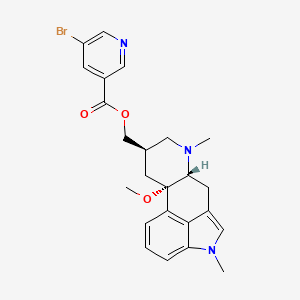Cerebrovascular insufficiency, Dementia, Peripheral circulatory disorders
Adult: 30 mg 1-2 times daily. Dosage recommendations may vary among countries or individual products. Refer to specific product guidelines.
|
Indications and Dosage
Oral
Cerebrovascular insufficiency, Dementia, Peripheral circulatory disorders Adult: 30 mg 1-2 times daily. Dosage recommendations may vary among countries or individual products. Refer to specific product guidelines.
|
|
Administration
Should be taken on an empty stomach.
|
|
Special Precautions
Patient with hyperuricaemia or history of gout. Renal impairment. Pregnancy.
|
|
Adverse Reactions
Significant: Hypotension, hyperuricaemia.
Gastrointestinal disorders: Gastric distress, pyrosis, constipation, diarrhoea, vomiting. General disorders and administration site conditions: Tiredness. Nervous system disorders: Dizziness, cephalea. Psychiatric disorders: Insomnia, drowsiness. Reproductive system and breast disorders: Sexual impotence, decreased libido. Vascular disorders: Flushing. |
|
Drug Interactions
May potentiate the effect of antihypertensive drugs.
|
|
Action
Description: Nicergoline is a semisynthetic ergot derivative that produces arteriolar vasodilatation both by direct vascular mechanism and by changes in tissue metabolism. At the cerebral level, it increases arterial flow and consumption of oxygen and glucose, thus reducing vascular resistance. It also exerts serotonergic and dopaminergic effects, antiplatelet activity, and improves EEG patterns.
Pharmacokinetics: Absorption: Rapidly and well-absorbed. Bioavailability: 5%. Time to peak plasma concentration: 1.5-3 hours (nicergoline); 3-5 hours (MDL); 0.5-1 hour (MMDL). Distribution: Volume of distribution: 224 L. Plasma protein binding: 34.7% (MDL); 14.7% (MMDL). Metabolism: Metabolised mainly via hydrolysis to 1-methyl-10 alpha-methoxy-9,10-dihydrolysergol (MMDL), then demethylated by CYP2D6 to form the main active metabolite 10-alpha-methoxy-9, 10-dihydrolysergol (MDL). Excretion: Mainly via urine (82%); faeces (10%). Elimination half-life: 11-20 hours (MDL). |
|
Chemical Structure
 Source: National Center for Biotechnology Information. PubChem Compound Summary for CID 34040, Nicergoline. https://pubchem.ncbi.nlm.nih.gov/compound/Nicergoline. Accessed Nov. 25, 2021. |
|
Storage
Store below 30°C. Protect from moisture.
|
|
ATC Classification
C04AE02 - nicergoline ; Belongs to the class of ergot alkaloids. Used as peripheral vasodilators.
|
|
References
Anon. Nicergoline. Lexicomp Online. Hudson, Ohio. Wolters Kluwer Clinical Drug Information, Inc. https://online.lexi.com. Accessed 09/11/2021. Buckingham R (ed). Nicergoline. Martindale: The Complete Drug Reference [online]. London. Pharmaceutical Press. https://www.medicinescomplete.com. Accessed 09/11/2021. Sermion (Pfizer). MIMS Thailand. http://www.mims.com/thailand. Accessed 09/11/2021.
|